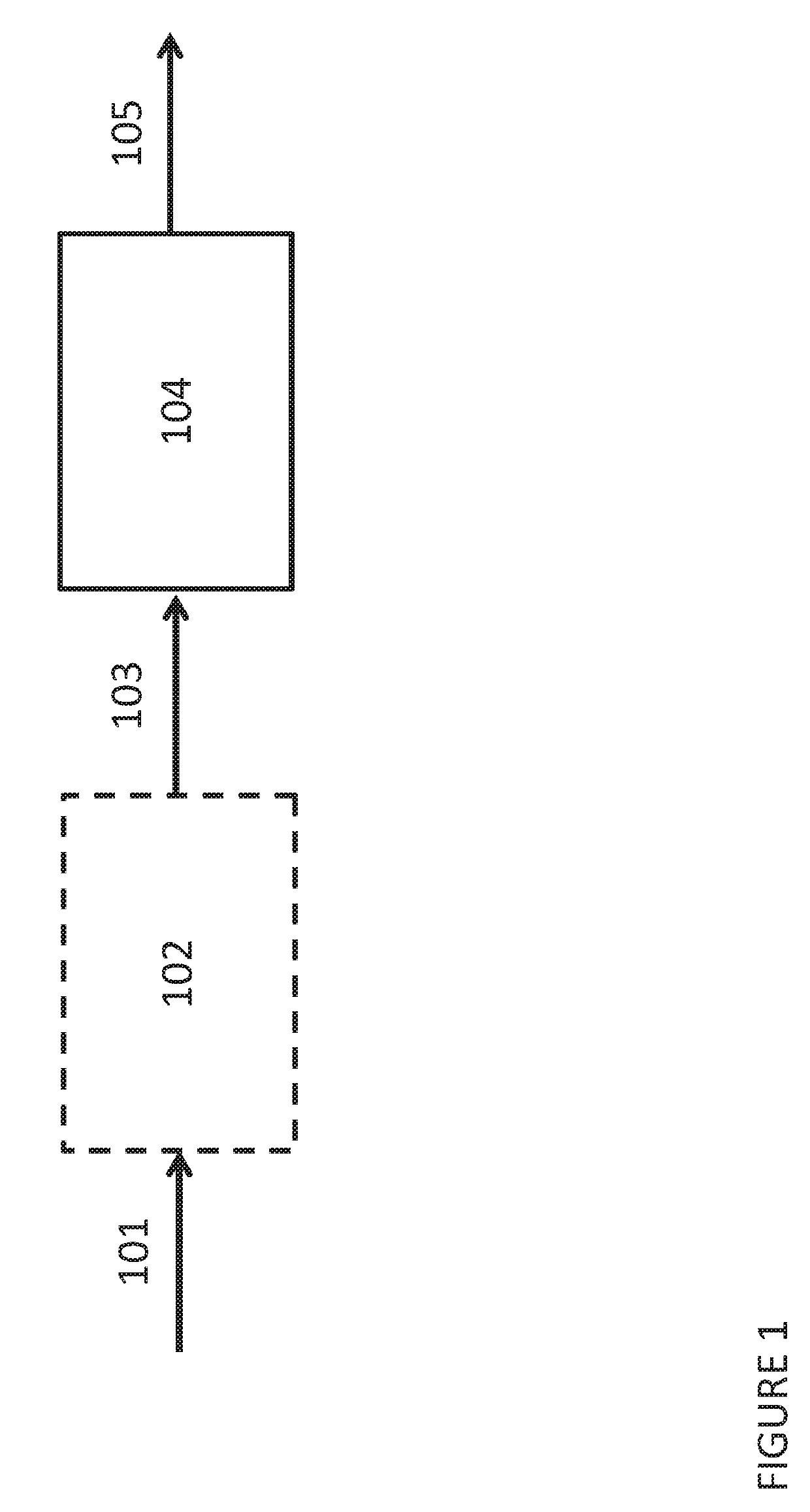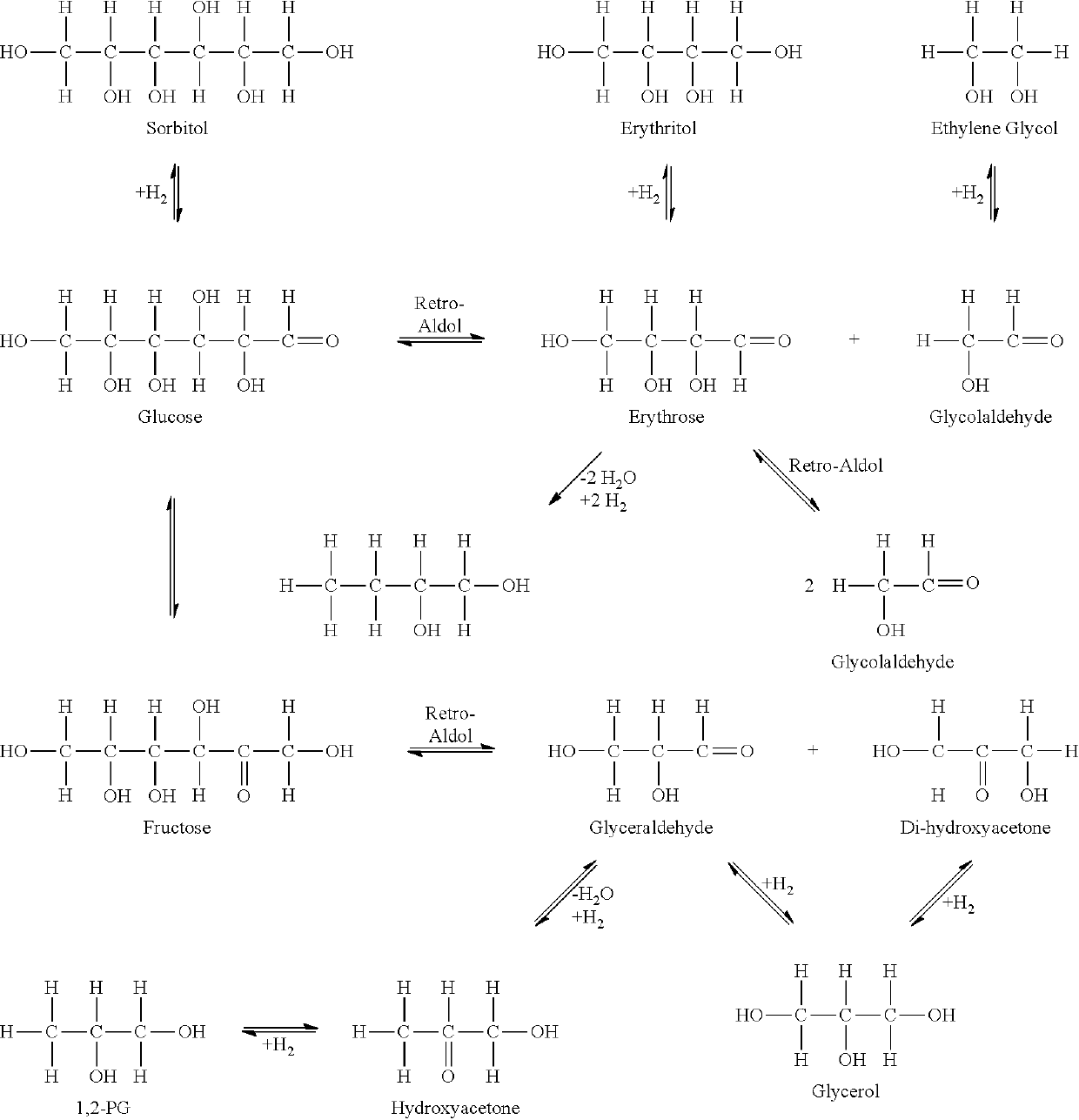Method for the production of glycols from sorbitol
a technology of sorbitol and sorbitol, which is applied in the field of preparing glycols, can solve the problems of reducing the overall yield of the higher-valued eg and pg, and achieves the effects of low energy consumption, low production cost and high percentage recovery of each produ
- Summary
- Abstract
- Description
- Claims
- Application Information
AI Technical Summary
Benefits of technology
Problems solved by technology
Method used
Image
Examples
example 1
[0038]In Example 1, 0.3 g of sorbitol and known weights of catalysts were added to 30 ml of water. The loaded autoclave was then purged three times with nitrogen, followed by hydrogen purge. The hydrogen pressure was then raised to 2000 psig or approximately 14 MPa of hydrogen and the autoclave was sealed and left stirring to perform a leak test.
[0039]After performing the leak test, the autoclave was de-pressurized to the target hydrogen pressure (1350 psig or 9.41 MPa) at room temperature, and closed. Next the temperature was ramped to the target run temperature of 220° C. as a fast ramp. The autoclave was held at the target temperature for 135 min, while both the temperature and pressure were monitored. After the required run time had elapsed, the heating was stopped, and the reactor was cooled down to room temperature, de-pressurized, purged with nitrogen and then opened.
[0040]The contents of the autoclave were then analyzed via Gas Chromatography (GC) or High Pressure Liquid Chr...
example 2
[0044]The same methodology as described in Example 1 was used for Example 2. The catalyst systems used in Example 2 are described in Table 3. Catalyst systems C and E are comparative examples. Catalyst systems D and F are according to the presently disclosed subject matter.
TABLE 3CatalystCatalyst 1Catalyst 2SystemCatalyst 1Amount, gCatalyst 2Amount, gCSodium0.05Copper chromite0.075carbonatecatalystDSodium0.05Cu / Zn / La oxides0.075carbonateESodium0.025Copper oxide 5-0.075carbonate15 wt.% / activatedcarbon (SudChemie C8-7)FSodium0.025Cu / Zn / La oxides0.075carbonate
[0045]The results of example 2 are provided in Table 4.
TABLE 4Catalyst SystemEG, wt %PG, wt %Glycerol, wt %C0.02.50.0D16.628.424.1E0.01.50.0F13.422.415.9
[0046]It is apparent from Table 4 that using only a copper-based catalyst with a sodium carbonate co-catalyst was not sufficient to achieve high glycol yields and that the catalyst system of the presently disclosed subject matter is necessary to achieve high yields of glycols. In ...
example 3
[0047]The same methodology as described in Example 1 was used for Example 3. The catalyst systems used in Example 3 are described in Table 5. Catalyst systems G through M are comparative examples. Catalyst system F is according to the presently disclosed subject matter.
TABLE 5CatalystCatalyst 1Catalyst 2SystemCatalyst 1Amount, gCatalyst 2Amount, gGSodium0.025CuO 41%,0.075carbonateCr2O3 43%,BaO 12% (SudChemie G22)HSodium0.025CuO 78%,0.075carbonateCr2O3 20%,contains bariumcompounds wt. % (SudChemie T-4419)ISodium0.025CuO 47%,0.075carbonateCr2O3 34%,BaO 6%Balance SiO2(Sud ChemieG22 / 2)JSodium0.025CuO 47%,0.075carbonateCr2O3 46%,MnO2 4%;BaO 2% (SudChemie G99)KSodium0.025Carulite 200 -0.075carbonateMnO2 60-75% / CuO 11-14% / AlO 8-18%LSodium0.025CuO 56%,0.075carbonateMnO2 Al2O3 balance(Sud Chemie T-4489)MSodium0.025CuO; ZnO; Mn0.075carbonateoxides (Sud Chemie T-4492)FSodium0.025Cu / Zn / La0.075carbonateoxides
[0048]The results of Example 3 are provided in Table 6 below.
TABLE 6Catalyst SystemEG, w...
PUM
| Property | Measurement | Unit |
|---|---|---|
| pressure | aaaaa | aaaaa |
| pressure | aaaaa | aaaaa |
| temperature | aaaaa | aaaaa |
Abstract
Description
Claims
Application Information
 Login to View More
Login to View More - R&D
- Intellectual Property
- Life Sciences
- Materials
- Tech Scout
- Unparalleled Data Quality
- Higher Quality Content
- 60% Fewer Hallucinations
Browse by: Latest US Patents, China's latest patents, Technical Efficacy Thesaurus, Application Domain, Technology Topic, Popular Technical Reports.
© 2025 PatSnap. All rights reserved.Legal|Privacy policy|Modern Slavery Act Transparency Statement|Sitemap|About US| Contact US: help@patsnap.com



